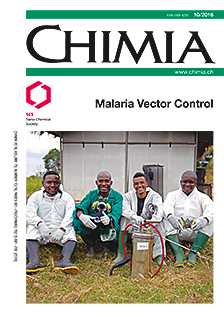Identification and Optimization of New Leads for Malaria Vector Control
DOI:
https://doi.org/10.2533/chimia.2016.698Keywords:
Adult mosquito screening, Aedes, Anopheles, Diphenyl ether, Malaria, New leads, Vector controlAbstract
A significant proportion of the world's population remains at risk from malaria, and whilst great progress has been made in reducing the number of malaria cases globally through the use of vector control insecticides, these gains are under threat from the emergence of insecticide resistance. The spread of resistance in the vector populations, principally to pyrethroids, is driving the need for the development of new tools for malaria vector control. In order to identify new leads 30,000 compounds from the Syngenta corporate chemical collection were tested in a newly developed screening platform. More than 3000 compounds (10%) showed activity at ?200 mg active ingredient (AI) litre–1 against Anopheles stephensi. Further evaluation resulted in the identification of 12 viable leads for the control of adult mosquitoes, most originating from current or former insecticide projects. Surprisingly, one of these leads emerged from a former PPO herbicide project and one from a former complex III fungicide project. This indicates that representatives of certain herbicide and fungicide projects and modes of action can also represent a valuable source of leads for malaria vector control. Optimization of the diphenyl ether lead 1 resulted in the identification of the cyano-pyridyl compound 31. This compound 31 exhibits good activity against mosquito species including rdl resistant Anopheles. It is only slightly weaker than permethrin and does not show relevant levels of cross-resistance to the organochlorine insecticide dieldrin.Downloads
Published
2016-10-26
Issue
Section
Scientific Articles
License
Copyright (c) 2016 Swiss Chemical Society

This work is licensed under a Creative Commons Attribution-NonCommercial 4.0 International License.
How to Cite
[1]
O. F. Hueter, M. Hoppé, P. Wege, P. Maienfisch, Chimia 2016, 70, 698, DOI: 10.2533/chimia.2016.698.







